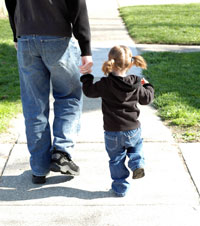The most common questions parents ask us involve concerns over proper development of their children. These developmental questions can spur from anxiety about height, weight, muscle and skeletal development. One area I am asked about quite frequently is a child’s walking or gait pattern. These questions often focus around concerns of not walking by a certain age, concerns about the direction their feet may be pointing, and even the development of leg length. Is one leg too short or is it too long? To add one more question to this list, “Should my child be wearing orthotics?”
We know their early years is when a child develops most of their skills of running, jumping, hopping, kicking, throwing, catching, balancing and climbing. Developing these skills is important between the ages of 3 to 5. When we consider the gait of the developing child, we know, beginning around two years old, that when a child stands, bowing of the legs and toeing in of the toes is common. From ages 3 to 5, the development often changes to a more “knock kneed” or valgus positioning at the knee, and toeing out is more common. When approaching the ages of 6 to 7 years old, the positioning of the knees and feet closely resembles the adult position.
This is also true of the three arches that make up the foot structure: medial, anterior and lateral arches. The importance of normal development of these arches allows the child a greater chance of improved gait biomechanics, especially allowing a normal heel-to-toe transition during the stance phase of the gait cycle. This major component of the gait cycle will aid the child as he develops the motor skills, which will allow him to jump higher, run faster and stand taller.
Considering the recommendation of custom-made, flexible orthotics for a child, we should examine the child as we would the adult:
• Are hereditary factors involved? (Are other family members wearing orthotics?)
• Is the gait pattern normal?
• Do they present with bowing of the Achilles, flaring of the feet (in or out), medial rotation of the patellas, unleveling of the pelvis or possible detection of a scoliosis?
• Finally, we should use the latest technology, such as scanning the foot, to further evaluate the foot structure.
 When is it too early to give a recommendation of custom-made orthotics? We know that, by age six, the arches are quite far along in their development. You are the doctor and, if you think they will benefit the child, then make the recommendation based on your clinical findings.
When is it too early to give a recommendation of custom-made orthotics? We know that, by age six, the arches are quite far along in their development. You are the doctor and, if you think they will benefit the child, then make the recommendation based on your clinical findings.
Children will all develop different levels of motor skills as they mature. I would like to share with you some time frames that involve the development of some specific developmental patterns. Balance is mostly fine tuned between the ages of 10 to 11 for boys, 9 to 10 for girls. Kinesthetic differentiation is the ability to correctly estimate differences in form, distance, timing, and the amount of strength required to perform movement. This is important from age 6 to 7 and again at 10 to 11 for both boys and girls. Reaction to acoustical and visual signs are best developed from ages 8 to 10 for both boys and girls. Rhythmic motion is developed from ages 9 to 10 for boys and 7 to 9 for girls. Spatial orientation occurs at ages 12 to 14 for boys and girls, while synchronization of movement in time occurs for both boys and girls from the ages of 6 to 8.
We know, in today’s society, many children would rather stay indoors and play a video game instead of going out and playing ball or skipping rope. However, we know this can contribute to childhood obesity, which is now reaching epidemic proportions. We must encourage our patients to take their children outside to play and explain the importance of helping children develop so they will have a head start on a healthy lifestyle. It is our oath as doctors of chiropractic that, “I will serve my patient to the best of my ability.”
A 1980 graduate of Palmer College of Chiropractic, Dr. Kirk Lee is a member of the Palmer College of Chiropractic Post Graduate Faculty and Parker College of Chiropractic Post Graduate Faculty. He has lectured nationwide on sports injuries and the adolescent athlete, and currently practices in Albion, Michigan.
